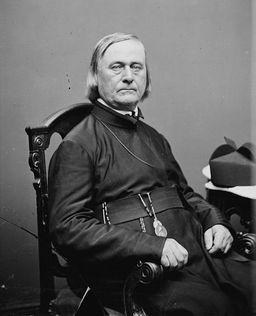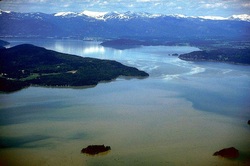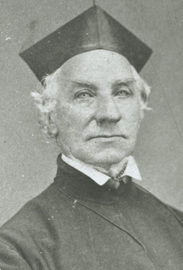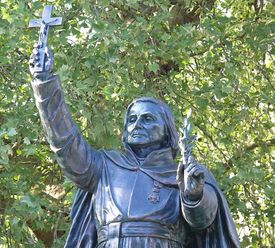 Father Pierre-Jean De Smet, c 1860-5
Father Pierre-Jean De Smet, c 1860-5
Coming back once again from St. Louis in the spring of 1845 he brought with him the Italian Jesuit priest Father Anthony Ravalli
De Smet was free to go out on further explorations of the area, his main goal being to meet some of the other tribes and get them interested in Catholicism. He set out from St. Mary’s Mission in August of 1845 on what would prove to be one of his biggest successes and greatest hardships. The journey would convince him to leave the Rocky Mountains for good.
A Final Foray West
 Lake Pend d’Oreille, Idaho
Lake Pend d’Oreille, Idaho
From there he reached the Bow River valley near Alberta, Canada. The group made it to Rocky Mountain House by October. He travelled out to meet more natives before heading up to Fort Edmonton as winter set in.
It was a successful journey in that De Smet met with Blackfeet, Chippewa, and Cree Indians. It was damaging to De Smet, however. By this time De Smet was 44 years old, a time when many men his age were not out trekking through the Rocky Mountains as winter set in; even the fur trade was over by 1840.
And the winter of 1845-46 really took its toll on the Jesuit leader of St. Mary’s. He somehow endured it and set out that spring, no doubt weakened and still in pain. The party traveled down the Columbia until they reached Fort Vancouver and from there he was able to get back to his mission.
Saying the Last Goodbye
 Father Gregory Mengarini
Father Gregory Mengarini
He packed his bags and left St. Mary’s and the Rocky Mountains for good, but not in bad faith. De Smet had been active in courting European interests and his work with both the Indians all up and down the Missouri River allowed him to become a mediator between them and the US government, a role he would continue in until his death in 1873.
Father Gregory Mengarini would become the Mission’s new leader, and it was a choice that would prove fateful. The Indians never had the liking for the dour Italian like they did for De Smet, especially when Mengarini began his attempts at converting the Blackfeet, the Flathead’s main enemy. Within five years the
A Final Journey
 Statue of De Smet in Dendermonde, Belgium
Statue of De Smet in Dendermonde, Belgium
His health declining rapidly, De Smet was still able to get himself up and christen his good friend Captain La Barge’s steamboat, which was named De Smet in his honor.
May 14th was a Sunday and De Smet was intent upon giving mass. Upon completing it he said that “this is the end. I shall never again ascend the altar.” The last sacrament was administered to him on May 20th, but he held out for another three days. The most famous American missionary of the 19th century died on May 23, 1873. He was 72 years old.
Baumler, Ellen. Montana Moments: History on the Go. Montana Historical Society Press: Helena, 2010. p 125.
Carriker, Robert C. Father Peter John De Smet: Jesuit in the West. University of Oklahoma Press: Norman, 1995. p 31-64, 236-8.
“History of St. Mary’s.” Historic St. Mary’s Mission & Museum. Web. Retrieved 7 June 2013 from Stmarysmission.org: http://www.saintmarysmission.org/history.html
Malone, Michael Peter; Roeder, Richard B.; Lang, William L. Montana: A History of Two Centuries. The University of Washington Press, 1976. p 62-3.
McLynne, Frank. Wagons West: The Epic Story of America’s Overland Trails. Random House: London, 2002. p 58-78.
"Pierre Jean De Smet." Encyclopedia of World Biography. 2004. Retrieved June 07, 2013 from Encyclopedia.com: http://www.encyclopedia.com/doc/1G2-3404701747.html
Toole, K. Ross. Montana: An Uncommon Land. University of Oklahoma Press: Norman, 1959. p 57-61.

